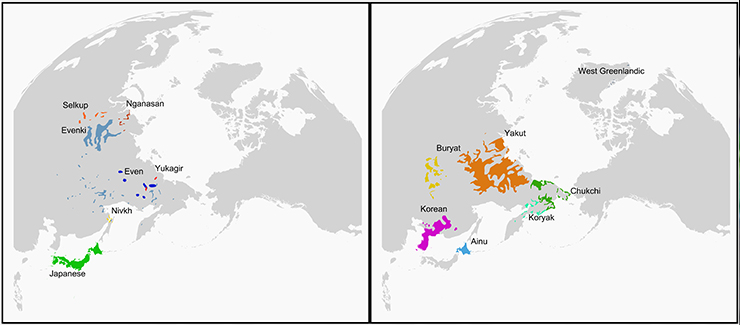A comparative study of cultures and genomes of populations in northeast Asia shows a remarkable correlation between genetics and grammar.

Fig. 1
The 14 populations, comprising 11 language families, tested for correlations in genetic, linguistic and musical variations
https://www.science.org/doi/10.1126/sciadv.abd9223
Humankind's present-day cultural diversity is the result of global migrations that have been happening over the course of many millennia. Reconstructing the history of these global migrations and associated cultural diversifications can, to some extent, be done by combining archaeological data with comparisons of biological and cultural characteristics of ethnicities. In this context, researchers have been looking at correlations in genetic and linguistic variations across ethnic groups ― language being one of people's most prominent cultural identifiers. Such analyses have been mostly limited to comparisons of populations within language families. But now, Associate Professor Patrick Savage of Keio University and colleagues have looked into genetic-cultural correlations across 11 language families from northeast Asia. One of their key findings is that grammar can be seen as a cultural indicator of a population's history.
The classic approach for comparing languages is the lexical method: by looking at groups of so-called cognates ― words in different languages sharing a common root ― relationships and evolutionary lineages can be easily established within one language family (e.g., Austronesian or Indo-European). The lexical approach is generally not applicable across linguistic families, however, as there simply are no words with the same root to compare. Yet, evidence of contact-induced similarities across language families exists. In a highly original and ambitious project, Savage and colleagues explored how grammatical, rather than lexical, features of languages relate to population history across linguistic families. In addition, they included musical parameters characteristic of the studied populations in their analysis ― indeed, music is another important cultural identifier of a population.
The researchers processed linguistic, musical, and genetic data of 14 populations encompassing 11 language families (including Japanese) in northeast Asia. (For the purposes of this study, 22 individuals belonging to the Nivkh ethnic group from Sakhalin Island in Russia were genotyped.) They carried out so-called "distance analyses" of grammatical, phonological, genetic, and musical properties, resulting in maps showing how close and interconnected the 14 populations are.
The most remarkable finding was that there is a significant correlation between genetic history and grammatical similarity, which may be due to existing relationships between languages before more recent contacts and inheritance that led to language families as we know them today. Regarding music, the scientists found no robust association with either genetics or language, but the scientists point out that further research with larger sample sets may be needed to clarify the relations between language, music, and genetics more conclusively.
Quoting the researchers, their results "... suggest that grammatical structure may reflect population history more closely than other cultural (including lexical) data," and that "different aspects of genetic and cultural data reveal different aspects of our complex human histories."
Published online 19 November 2021
Reference
- H. Matsumae, P. Ranacher, P. E. Savage, D. E. Blasi, T. E. Currie, K. Koganebuchi, N. Nishida, T. Sato, H. Tanabe, A. Tajima, S. Brown, M. Stoneking, K. K. Shimizu, H. Oota, B. Bickel, Exploring correlations in genetic and cultural variation across language families in northeast Asia. Sci. Adv. 7, eabd9223 (2021). | article